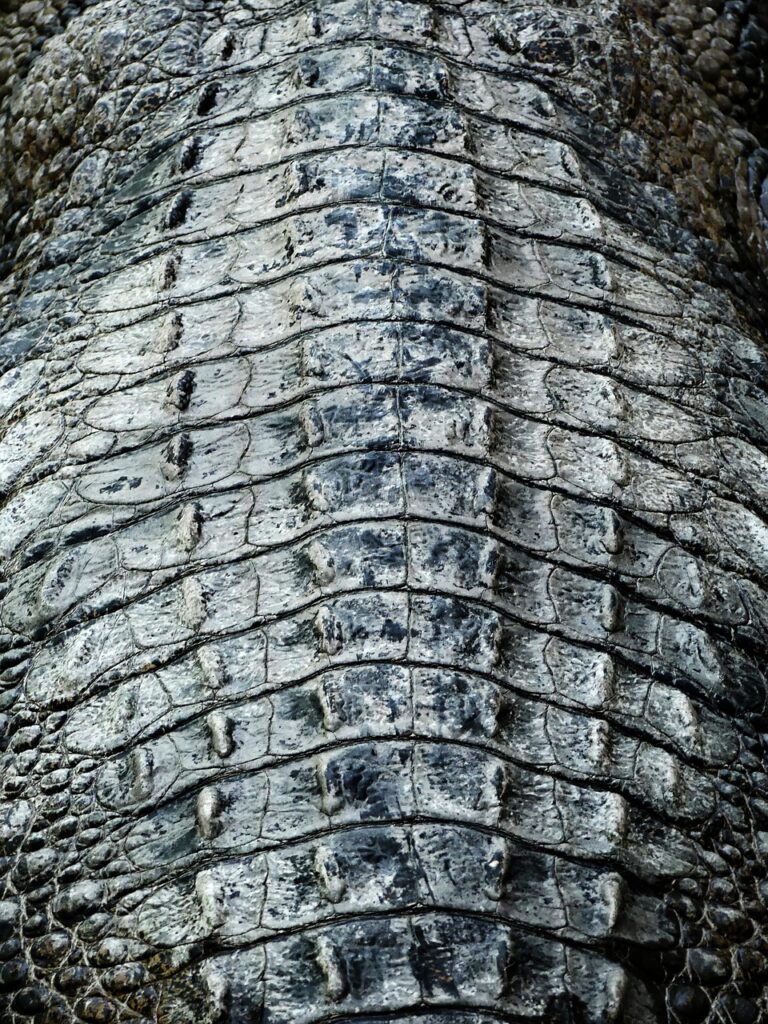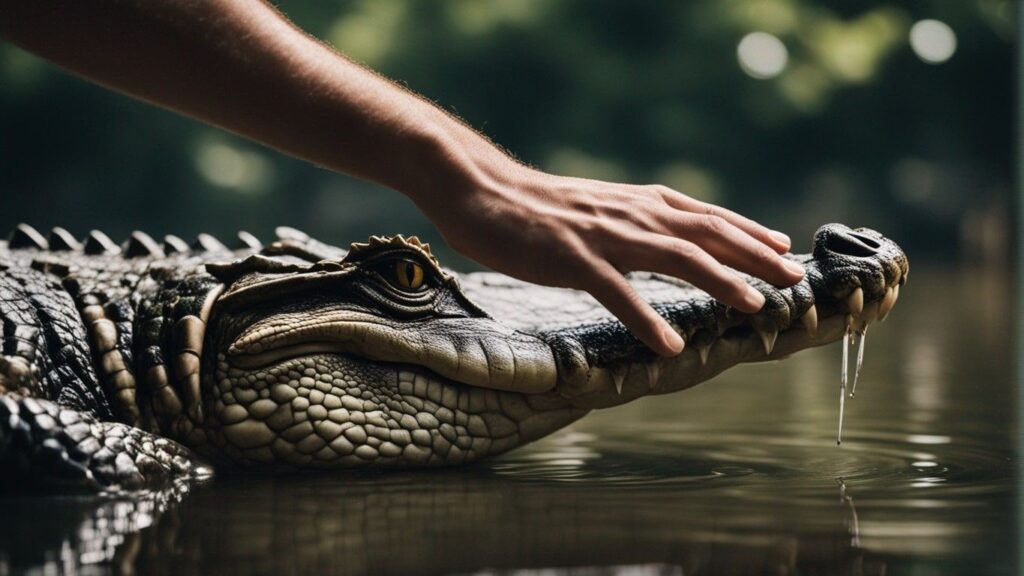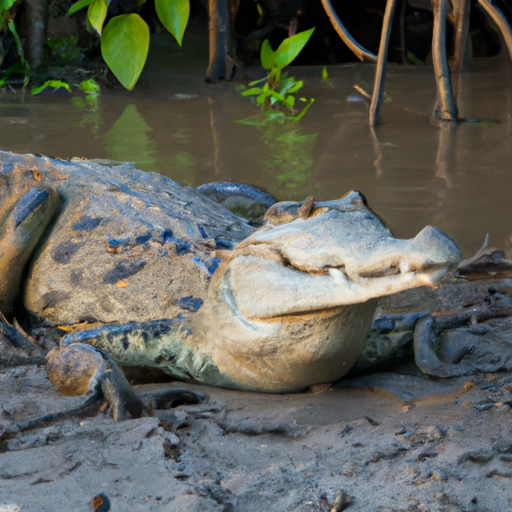So you’ve probably heard of snakes shedding their skin, but have you ever wondered if crocodiles do the same? Well, the answer might surprise you.
Like snakes, crocodiles actually do shed their skin, but not in the same way. While snakes shed their skin all at once, crocodiles shed it in small pieces.
In this article, we’ll explore why crocodiles shed their skin and how this process occurs. Get ready to discover the fascinating world of crocodile skin shedding!

The Process of Shedding
Shedding is an essential process for crocodiles, as it allows them to maintain healthy and functional skin. Crocodile skin is structured in scales, which provide protection, regulate body temperature, and assist in locomotion. Shedding, also known as molting or ecdysis, allows crocodiles to replace old and damaged skin with new, healthy ones. It is an intricate process that involves the loosening, shedding, and regeneration of scales.
The Purpose of Shedding
The primary purpose of shedding in crocodiles is to ensure the integrity and functionality of their skin. Over time, the outer layer of crocodile scales becomes worn and damaged due to environmental factors and regular activity. Shedding enables crocodiles to remove this damaged layer and replace it with a new one, allowing for proper growth, protection, and maximum efficiency in their environment.
Frequency of Shedding
Crocodiles engage in shedding several times throughout their lifetime. The frequency of shedding varies depending on factors such as age, growth rate, and environmental conditions. Young crocodiles may shed more frequently than adults due to their rapid growth. On average, crocodiles shed their skin every few months, but this can vary between individuals and species.
Initiation of Shedding
The shedding process is initiated by a combination of environmental and physiological factors. As crocodiles grow, their skin becomes tighter, leading to the initiation of shedding. Environmental cues, such as changes in temperature and photoperiod, also play a role in triggering shedding. These cues signal to the crocodile’s body that it is time to shed its skin and begin the regeneration process.
Duration of Shedding
The duration of shedding can vary depending on the size and health of the crocodile, as well as other individual factors. Generally, the shedding process takes several days to complete. During this time, the crocodile will gradually loosen and shed its old scales. The duration also depends on the size and number of scales being shed. Larger crocodiles with more scales may take longer to complete the shedding process.
Physical Changes During Shedding
During the shedding process, crocodiles undergo various physical changes as their old scales are replaced with new ones. These changes are essential for maintaining the functionality and protective properties of their skin.
Loosening of Scales
As the shedding process begins, crocodile scales gradually loosen from their underlying layers. This loosening is facilitated by specialized enzymes that break down the proteins binding the old scales together. As a result, the old scales become easier to detach from the crocodile’s body.
Visible Signs of Shedding
One of the most apparent signs of shedding in crocodiles is the presence of loose or peeling skin. This can be observed in various parts of the crocodile’s body, including the head, back, and tail. Additionally, crocodiles may exhibit a duller appearance during shedding, as the old scales lose their luster and color.
Color Changes
During shedding, crocodile scales may undergo temporary color changes. This can result in a faded or dull appearance, making the crocodile less vibrant than usual. However, once the shedding process is complete, the new scales will regain their natural coloration.
Texture Changes
Another noticeable physical change during shedding is the alteration of the crocodile’s skin texture. The old scales become dull and rough, gradually breaking away as the new scales form underneath. This texture change is temporary and will revert to normal once the shedding process is completed.

Adaptations for Shedding
Crocodiles have several unique adaptations that facilitate the shedding process and ensure its successful completion. These adaptations are crucial for the health and well-being of crocodiles.
Unique Skin Structures
Crocodile skin is composed of various layers and specialized structures that aid in shedding. One such structure is the epidermis, which consists of multiple layers of cells that produce new scales. The dermis, located beneath the epidermis, contains blood vessels and provides nourishment to the skin during shedding.
Enzymes for Skin Breakdown
Crocodile skin undergoes enzymatic breakdown during shedding, allowing for the loosening and removal of the old scales. Specialized enzymes called proteases are responsible for breaking down the proteins that bind the scales together. This enzymatic activity makes shedding possible and aids in the regeneration of new, healthy scales.
Regeneration of Damaged Scales
Shedding not only allows crocodiles to replace old scales but also enables the regeneration of damaged ones. If a crocodile has sustained injuries or lesions on its skin, shedding provides an opportunity for these damaged scales to be replaced with healthy ones. This regeneration process ensures the crocodile’s skin remains intact and fully functional.
Defense Mechanisms During Shedding
Crocodiles have developed unique defense mechanisms to protect themselves during the vulnerable shedding process. They may exhibit increased aggression and territorial behavior to deter potential threats. Additionally, crocodiles may change their activity patterns during shedding, becoming less active and hiding in secure locations until the process is complete.
Factors Affecting Shedding
Several factors can influence the shedding process in crocodiles. Understanding these factors is crucial for monitoring the health and well-being of crocodile populations and ensuring their conservation.
Environmental Factors
Environmental conditions play a significant role in regulating the shedding process. Temperature, humidity, and photoperiod can influence the initiation and progression of shedding. Crocodiles in colder environments may experience slower shedding rates compared to those in warmer climates.
Physiological Factors
Physiological factors, such as age and growth rate, can impact the shedding frequency and duration in crocodiles. Younger crocodiles that are experiencing rapid growth may shed more frequently than adults. Additionally, individual health and genetic factors can also influence shedding patterns.
Health and Nutrition
The overall health and nutrition of crocodiles can affect the shedding process. Poor nutrition or underlying health issues may delay or inhibit shedding, leading to abnormal shedding patterns. Adequate nutrition, including a balanced diet and proper hydration, is crucial for the successful completion of shedding.
Age and Growth Rate
Young crocodiles tend to shed more frequently than adults due to their higher growth rates. As crocodiles mature, their growth rate slows down, resulting in less frequent shedding. However, the shedding process remains essential throughout their lifetime to ensure healthy and functional skin.

Comparative Shedding in Crocodilians
Different crocodilian species may exhibit variations in their shedding patterns and processes. Understanding these differences is vital for studying and conserving different crocodile species.
Shedding in Alligatoridae Family
Alligators, a member of the Alligatoridae family, also engage in shedding to maintain healthy skin. The shedding process in alligators is similar to that of crocodiles, involving the gradual loosening and shedding of old scales. However, specific variations may exist in shedding frequency and duration between different alligator species.
Shedding in Crocodylidae Family
Crocodiles, belonging to the Crocodylidae family, have distinct shedding patterns compared to other crocodilian species. They typically shed less frequently than alligators and may exhibit longer shedding durations. These differences may be influenced by various factors, such as habitat, climate, and evolutionary adaptations.
Shedding in Gavialidae Family
The gharial, a member of the Gavialidae family, also undergoes shedding to maintain healthy skin. Gharials have a unique snout morphology and specialized dentition. The shedding process in gharials is similar to that of other crocodilians, although specific variations may exist due to their distinct evolutionary adaptations.
Differences and Similarities
While shedding is a common process among all crocodilians, specific variations exist between different species and families. Factors such as shedding frequency, duration, and physiological adaptations differ among crocodilian species. Understanding these differences enhances our knowledge of their biology and aids in conservation efforts.
Behavioral Aspects of Shedding
Shedding not only brings about physical changes in crocodiles but also affects their behavior. Crocodiles exhibit various behavioral patterns and modifications during the shedding process.
Hiding and Resting Patterns
Crocodiles tend to seek out secluded and secure locations during shedding, likely to minimize disruption and vulnerability. They may hide in vegetation, burrows, or other structures to shelter themselves until the shedding process is complete. Resting patterns may also change, and crocodiles may spend more time immobile or resting near water.
Increased Irritability
Crocodiles may become more irritable and aggressive during shedding. This increased irritability is likely a defensive mechanism to protect themselves during this vulnerable period. It is important to exercise caution and avoid unnecessary interactions with crocodiles during shedding to prevent conflict or accidents.
Reduced Feeding Activity
During shedding, crocodiles may exhibit reduced feeding activity. This decrease in appetite is thought to be a consequence of the physiological changes and discomfort associated with shedding. By conserving energy and minimizing movement, crocodiles can focus on the shedding process and reduce the risk of injury or complications.
Post-shedding Behavior
After completing the shedding process, crocodiles often return to their regular activity patterns and feeding routines. Their behavior and temperament normalize, and they continue with their normal hunting and territorial activities. The new, healthy scales provide optimal protection, allowing crocodiles to resume their daily activities with renewed vigor.
Role of Shed Skin
The shed skin of crocodiles serves several purposes and plays important roles in their ecosystems and human societies.
Protection and Barriers
Shed skin acts as a form of protection for crocodiles, as it provides a barrier against external threats and harmful organisms. The shed skin covers and shields the underlying layers of the crocodile’s body, ensuring that it remains intact and safeguarded from environmental factors.
Nutritional Benefits
Shed skin contains valuable nutrients that can be beneficial to other organisms in the ecosystem. In certain habitats, insects and other small organisms feed on shed skin, using it as a food source. This contribution to the local food chain provides nourishment to various species and promotes ecosystem stability.
Disposal and Decomposition
Shed skin, once discarded by crocodiles, decomposes over time. The decomposition process recycles nutrients back into the environment, supporting nutrient cycling within ecosystems. Additionally, shed skin breaking down naturally contributes to soil fertility, aiding in the growth and development of plants and other organisms.
Human Uses of Shed Skin
In some cultures and societies, shed crocodile skins are utilized for various purposes. The skin of crocodiles is highly valued for its unique texture and durability. It is commonly used in the production of luxury goods such as handbags, shoes, and accessories. However, it is crucial to ensure responsible and sustainable practices to prevent the depletion of crocodile populations.
Potential Hazards and Risks
While shedding is a natural process for crocodiles, several hazards and risks can arise during this period. It is important to be aware of these potential issues to ensure the health and well-being of crocodile populations.
Skin Infections
During shedding, the exposed and vulnerable skin of crocodiles can be prone to infections. Microorganisms, such as bacteria or fungi, may invade the damaged skin, leading to infections. These infections can cause discomfort, pain, and potentially affect the overall health of the crocodile.
Parasitic Infestations
Crocodiles experiencing shedding may be more susceptible to parasitic infestations. Parasites, such as ticks or mites, can take advantage of the weakened and exposed skin to attach themselves to the crocodile. These infestations can negatively impact the health and vitality of the crocodile if left untreated.
Abnormal Shedding Patterns
Abnormal shedding patterns can occur due to various factors, including stress, poor nutrition, or underlying health issues. Abnormal shedding may involve incomplete shedding, delayed shedding, or irregular shedding cycles. These patterns can indicate underlying health problems and should be monitored and addressed by experts.
Impacts on Health and Well-being
The shedding process can be physically demanding for crocodiles. Prolonged or frequent shedding cycles can result in physiological stress and may compromise the overall health and well-being of crocodile populations. Monitoring and managing shedding patterns are essential for the conservation and preservation of crocodile populations.
Conservation Implications
Understanding shedding patterns and behaviors in crocodiles has significant implications for their conservation and management.
Monitoring Shedding Patterns
Monitoring shedding patterns provides valuable information on the health and well-being of crocodile populations. Abnormal shedding patterns may be indicative of underlying health issues or environmental stressors. Regular monitoring enables early detection of problems and facilitates targeted conservation interventions.
Indicators of Environmental Conditions
Shedding patterns can serve as indicators of environmental conditions and habitat quality. Any significant changes in shedding frequency or duration may suggest shifts in food availability, climate, or other factors affecting the crocodile’s habitat. These indicators help researchers and conservationists assess the overall health of ecosystems and implement appropriate management strategies.
Preserving Shedding Habitats
Conserving the habitats essential for the shedding process is crucial for the survival of crocodile populations. Maintaining suitable nesting areas, water quality, and ecological integrity ensures the availability of healthy environments for crocodiles to shed their skin successfully. Conservation efforts should focus on preserving these habitats to support the natural processes of crocodiles.
Educating the Public
Public education plays a vital role in raising awareness and dispelling myths and misconceptions surrounding crocodile shedding. Providing accurate information about shedding processes, behavioral changes, and conservation implications can help foster positive attitudes towards crocodile conservation. Public support and involvement are essential for the long-term sustainability of crocodile populations.
Myths and Misconceptions
Several myths and misconceptions surround the shedding process in crocodiles. Clarifying these misconceptions helps promote a better understanding of crocodile biology and behavior.
Crocodile vs. Snake Shedding
While snakes are well-known for their shedding process, crocodiles undergo shedding as well. However, the shedding process in crocodiles differs significantly from that of snakes. Crocodiles shed their scales in sections, whereas snakes shed their entire outer skin in one piece.
Shedding for Growth
Shedding is not solely a process for growth in crocodiles. While shedding does allow for the replacement of damaged or worn scales, its primary purpose is to maintain healthy and functional skin. Crocodiles shed to remove old scales and to replace them with new ones, regardless of their growth rate.
Shedding as a Defensive Mechanism
Although crocodiles may exhibit increased irritability and aggression during shedding, shedding itself is not a defensive mechanism. Increased aggression during shedding is likely a response to vulnerability and discomfort. Crocodiles rely on their physical adaptations and behavior to defend themselves, rather than shedding.
Shedding and Crocodile Behavior
While shedding can influence crocodile behavior, it is not the sole determinant of their behavior. Crocodiles exhibit a range of behaviors that are not directly related to shedding, such as feeding, mating, and territorial activity. Shedding is just one aspect of their overall behavior and biology.
Final Thoughts
In conclusion, shedding is a vital process for crocodiles that ensures the health and functionality of their skin.
It involves the gradual loosening, shedding, and regeneration of old scales. Crocodile skin structures, enzymes, and defense mechanisms are all adapted to facilitate the shedding process.
Various factors, including environmental conditions and physiological factors, influence shedding patterns and duration.
Shedding behavior and post-shedding adaptations impact crocodile behavior and feeding activity.
Shed skin has multiple roles, including protection and nutritional benefits. However, shedding also poses potential hazards and risks, such as skin infections and abnormal shedding patterns.
Understanding shedding patterns and behaviors has conservation implications and helps dispel myths and misconceptions.
By comprehensively studying shedding, we can gain insights into crocodile biology, promote conservation efforts, and preserve their habitats.




